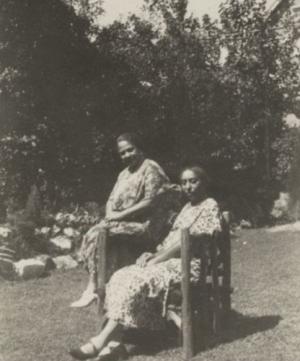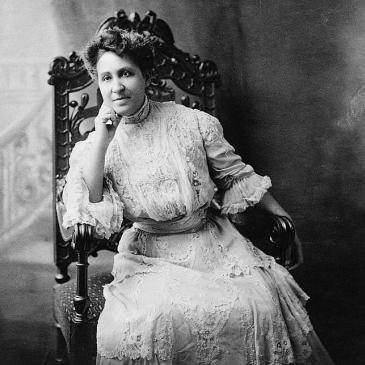Mary Burrill

Mary P. Burrill was a celebrated playwright whose works inspired many prominent writers of the New Negro Movement/Harlem Renaissance. She used her plays to confront many topics, including, but not limited to, lynching, the Black experience, and bodily autonomy for women.
Mary Powell Burrill, occasionally referred to as “Mamie,” was born on August 1st, 1881 in Washington, DC to parents John H. Burrill and Clara E. Burrill. She remained in DC until 1901 and graduated from M Street High School—now known as Dunbar High School— that same year (Queerplaces). Dunbar was one of the first high schools for Black students. Many prominent educators and graduates are associated with the school, such as Eleanor Holmes Norton. While attending Dunbar, Burrill shared a romance with fellow student Angelina Weld Grimké. Their connection was enough to ignite Burrill’s passion for writing and, subsequently, shift the course of her life.
Grimké would grow to become a Black journalist, poet, and playwright who would later encourage Burrill to pursue a career as a playwright as well. In 1896, when Burrill was 15, she wrote to Grimké to express her affections: “Could I just come to meet thee once more, in the old sweet way, just coming at your calling, and like an angel bending o'er you breathe into your ear, ‘I love you'” (Queerplaces). Grimké responded zealously, reciprocating Burrill’s devotion. She wrote, “Oh Mamie if you only knew how my heart beats when I think of you and it yearns and pants to gaze, if only for one second upon your lovely face” (Queerplaces). Despite these declarations, the romance between the two did not last.
Burrill and her parents moved to Boston post-graduation, where she continued her impressive academic career at the Emerson College of Oratory. She received her degree three years later in 1904. Burrill was the first woman of color to graduate from Emerson (Clossey 2023). After college graduation, Burrill returned to Washington, DC. She taught for many years between 1905 and 1944. Burrill worked at a variety of schools. These institutions included the Armstrong Manual High School (from 1905-1907), the Washington Conservatory of Music and School of Expression (from 1907-1911) -- where, notably, she served as the director-- and Dunbar High School (from 1911-1944) (DC Writers’ Homes 2020, DC Preservation League 2021). The subjects she taught were also varied, ranging from English to Speech to Drama.
In 1912, amid her teaching career, Burrill would meet her long-term romantic partner, Lucy Diggs Slowe. Originally living in Baltimore when they met, Slowe was also an educator who taught English like Burrill. Slowe would eventually move to DC to follow Burrill and taught at Armstrong Manual High School too. This prompted the two to move in together, changing residences within DC at various times throughout their relationship To combat discrimination due to their identities as queer women, Burrill and Slowe never publicly stated that they were a couple. However, they were recognized as such by their closest friends.
Burrill’s plays are a prominent part of her legacy. She wrote The Other Wise Man in 1905.It wasn’t until 1919 that she wrote the two plays considered some of her best work (DC Writers’ Homes 2020). They That Sit in Darkness takes place in the rural South and highlights the realities of being a young mother with multiple children. When the play’s matriarch Malinda Jasper passes at age 38, she leaves behind seven children. Her 17-year-old daughter, Lindy Jasper, is then tasked with tending to family matters (Smith 2015). As a result of this tragedy, Lindy realizes she will no longer be able to pursue an education. The Jaspers also live in deep poverty, impacting their access to food and quality healthcare. They That Sit in Darkness aimed to highlight the cyclical nature of poverty due to systemic problems. As such, the play directly combated pre-existing stereotypes that suggested Black people were “... inherently lazy, unintelligent, and “prolific” breeders” (Smith 2015). Burrill’s work was groundbreaking, as she wrote the play from the perspective that Black poverty did not stem from inferiority, but rather “the cyclical oppression which trapped African Americans and, in particular, black women” (Smith 2015).
Ultimately, American activist Margaret Sanger published They That Sit in Darkness in her progressive publication Birth Control Review. Sent out every month, the works the Review featured were in support of reproductive rights, a cause Burrill believed in wholeheartedly (Queerplaces). Burrill’s pieces were controversial and ahead of their time. Most notably They That Sit in Darkness “...advocated birth control as a means to escape poverty long before women were given reproductive rights'' (Queerplaces). This piece has been deemed a protest play in recent years by American Studies historians due to its timely and striking commentary (Hebel 1996).
Aftermath, Burrill’s second most prominent play, was set in rural South Carolina. It depicts a young soldier named John returning from World War I who, upon making it home, finds that his father has been a victim of a most heinous crime - lynching. John has just earned a medal for his bravery in fighting off German soldiers. In doing so, he saved the lives of his company. Upon returning home, he faces the reality that his service (and those of other Black Americans in war) did not free him or his community from discrimination and violence. Burrill constructed this revolutionary narrative with intention, underlining that “American society…forces Blacks to fight in foreign wars to protect white Americans while African Americans go unprotected from terrorists who lynch and burn” (Brown-Guillory, 1988, p. 9). In the play, John seeks revenge on the white man responsible for the murder of his father. Aftermath inspired various plays by other playwrights that would adopt the same rhetoric of combating hate crimes and intimidation tactics through vengeance. As such, John is “... an example of the assertive black male who selflessly and fearlessly confronts racial oppression” (Harris 1994, p. 212). Featured in The Liberator, a publication created by socialist Max Eastman, the play was eventually performed in New York City in 1928 (Queerplaces).
Undoubtedly dedicated to her creative pursuits, Burrill and Slowe worked to create safe spaces for other DC creatives, namely within their own home. Records show “the house was known as a refuge for Howard University’s female students, and Slowe regularly hosted get-togethers there to talk, counsel and encourage her young charges. The women also received many other guests there, mostly educators such as Mary McLeod Bethune, but also politicians and activists from around the country” (DC Preservation League 2021). Their shared home hosted various artists of all mediums – for example Georgia Douglas Johnson, amongst many others. Outside of the house Burrill spent time at Johnson's home, alternately known as the “S Street Salon,” which, by the 1920s, “had become the dominant force in black playwriting” (Harris 1994, p. 207, 213). These activists would not only discuss their plays but a variety of current events ranging from lynching to women's rights. Burrill was also a member of the DuBois Circle, a literary Black women's group (DC Preservation League 2021).
Amidst these successes and various gatherings, Burrill returned to Emerson College in 1929 to pursue further education and received a bachelor of literary interpretation that following year (Emerson College). She then returned to DC to continue teaching. Through her plays and her work as an educator, Burrill taught various writers whose writings were integral to the New Negro Movement/Harlem Renaissance. Centered in the early 1910s and lasted until the late 1930s, historians describe this period as “...the development of the Harlem neighborhood in New York City as a Black cultural mecca… and the subsequent social and artistic explosion that resulted…manifesting in literature, music, stage performance, and art” (History 2009). Writers such as Willis Richardson and May Miller were among her most celebrated former students. Richardson was the first Black playwright to have one of his plays performed on Broadway, while Miller published Pandora's Box, a play she created while still in attendance at Dunbar (Queerplaces). As such, Burrill’s impact on writing stemmed not only from her plays, but her influence on her students.
Her partner, Lucy Diggs Slowe, was also quite successful. At the height of her career in 1922, she became the first Dean of Women at Howard University (DC Writers’ Homes 2020). Burrill and Slowe remained together for 25 years, until Slowe’s passing in 1937. Devastated due to the loss of her partner to kidney disease, Burrill remained devoted to keeping Slowe’s memory alive, so much so that she “...kept Slowe’s picture on her piano, next to a vase filled with white carnations” (Queerplaces). Following this great loss and a subsequent retirement from teaching a few years later, Burrill moved to New York in 1944. She died in New York at age 64 on March 13th, 1946. Burrill’s body returned to DC for burial in Woodlawn Cemetery.
They That Sit in Darkness and Aftermath provide ample insight into the experiences of Black Americans in the early 20th century. By creating these plays and educating the next generation of playwrights, Burrill played a crucial role in the continued development of Black art. Students May Miller and Willis Richardson were trailblazers in their own right, with Burrill paving their way fearlessly. That said, her legacy has expanded far beyond her creative contributions. In 2002, Emerson College announced the Mary Burrill Scholarship. The college describes the scholarship as an opportunity to “support first-year diverse and/or economically disadvantaged students, to continue Burrill’s legacy” (Emerson College). Additionally, as of 2020, the Slowe-Burrill house (located at 1256 Kearny St. NE), where the pair lived for 15 years, has been added to the National Register of Historic Places (National Park Service).
Discussion Questions:
-
If you were to create a play about events you believe to be important in the current moment, what topics would you cover?
-
What impact did Mary Burrill’s teachings and plays have on the New Negro Movement/Harlem Renaissance?
-
How did the intersections of Burrill’s identity (specifically Blackness and womanhood) show up thematically in her works?
- Abramson, D. E. Angelina weld grimké, mary T. burrill, georgia douglas johnson, and marita O. bonner: An analysis of their plays. Sage, 2(1), 9. 1985. https://www.proquest.com/scholarly-journals/angelina-weld-grimké-mary-t-burrill-georgia/docview/1300123052/se-2.
- Brown-Guillory, Elizabeth. Their Place on the Stage: Black Women Playwrights in America. 1988. New York City, New York: Greenwood Press.
- Clossey, Erin. “Honoring Black History Month: Mary P. Burrill.” Emerson Today, January 27, 2023. https://today.emerson.edu/2021/02/05/honoring-black-history-month-mary-p-burrill/.
- Harris, Will. “Early Black Women Playwrights and the Dual Liberation Motif.” African American Review 28, no. 2. 1994. 205–21. https://doi.org/10.2307/3041994.
- “Harlem Renaissance - Definition, Artists & How It Started.” History. October 29, 2009. https://www.history.com/topics/roaring-twenties/harlem-renaissance.
- Hebel, Udo J. “Early African American Women Playwrights (1916-1930) and the Remapping of Twentieth-Century American Drama.” AAA: Arbeiten Aus Anglistik Und Amerikanistik 21, no. 2. 1996. 267–86. http://www.jstor.org/stable/43025507.
- “Mary P. Burrill.” DC Writers’ Homes, November 29, 2020. https://dcwritershomes.wdchumanities.org/mary-p-burrill/.
- “Mary Burrill Scholarship.” Emerson College, n.d. https://emerson.edu/support-emerson/our-giving-priorities/mary-burrill-scholarship.
- Queerplaces - Mary P. Burrill. n.d. http://www.elisarolle.com/queerplaces/klmno/Mary%20P.%20Burrill.html.
- Smith, David B. "Intersectionality in the Dramas of Mary Burrill, Alice Childress, and Pearl Cleage". Continuum, January 2015. https://continuumjournal.org/index.php/33-volumes/issues/vol-1-no-2contet/ysc-1-2/93-intersectionality-in-the-dramas-of-mary-(11-alice-childress-and-pearl-cleage
- DC Preservation League. “The Slowe-Burrill House with EHT Traceries, Inc..” YouTube, April 2, 2021. https://www.youtube.com/watch?v=WPLj heBEI.
- “Weekly List 20201009.” National Park Service. n.d. https://www.nps.gov/subjects/nationalregister/weekly-list-20201009.htm.
MLA – Dawson, Shay. "Mary Burrill." National Women's History Museum. National Women's History Museum, 2023. Date accessed.
Chicago - Dawson, Shay. “Mary Burrill." National Women's History Museum. 2023.
Media Citations:
- Photo courtesy of Moorland Spingarn Research Center, Howard University.
- “Women’s History Month: Celebrating Mary Burrill.” YouTube. Emerson College, March 16, 2023. https://www.youtube.com/watch?v=_xbmfg7Kis4.
Burrill, Mary P. “THEY THAT SIT IN DARKNESS: A Play in One-Act.” 1919. https://www.one-act-plays.com/dramas/they_that_sit_in_darkness.html.





